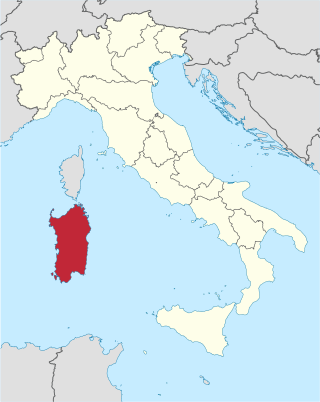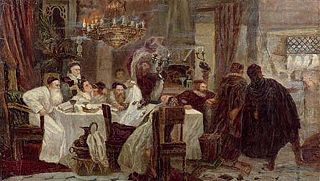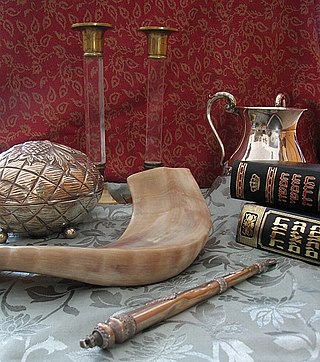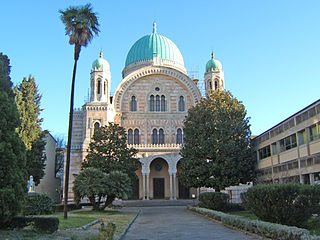
The history of the Jews in Sardinia can be traced three millennia back. The modest Jewish community in Sardinia consisted of Sephardic Jews of Spanish and Italian descent.
| Part of a series on |
| Jews and Judaism |
|---|

The history of the Jews in Sardinia can be traced three millennia back. The modest Jewish community in Sardinia consisted of Sephardic Jews of Spanish and Italian descent.
The first recorded mention of Jews in Sardinia occurred in the year 19, during the reign of Roman emperor Tiberius. 4000 Jews were exiled from Rome to Sardinia. [1] Little recorded Jewish history of early Sardinia remains but it is presumed they led a quiet, provincial life with full rights along with the natives. They even left a mark on Sardinian itself in words like Friday that, unlike the other Romance languages, is actually chenàpura or cenàpura, deriving its name from the Latin cena pura in order to designate the food prepared for Shabbat eve. [2] When Christianity became the state religion of Rome, Jewish rights everywhere, including Sardinia, became curtailed. After the fall of Rome, a succession of foreign rulers became the governors of Sardinia and life for the Jews became increasingly harsh. Sardinia is one of the few places in Italy where there are catacombs containing Jewish inscriptions. The catacombs of Sant'Antioco date from the 4th and 5th centuries, and the inscriptions therein are in a form of Hebrew-Latin. [3]
In 1325, Sardinia fell under the rule of the Kingdom of Aragon. For the first century during Iberian rule, life was more or less pleasant for Sardinian Jews. During this time Spanish Jews began to arrive and settle on the island. The Jewish inhabitants of Marseille fleeing violence in 1484 and again in 1485, which led to an exodus of Jews from the city, settled in Sardinia which became home to about 200 Jewish families from Marseille [4] Also, in 1485, the Jews of Sardinia were declared property of the King of Aragon and were governed by his authority alone. [5]
Many Jewish families lived in the capital of the Kingdom of Sardinia, Cagliari, where there was a large synagogue. [6] This synagogue was eventually forcibly converted into a Roman Catholic Church, which today goes by the name of Santa Croce [7] However, the largest Jewish community in Sardinia was located in the city of Alghero. Many Jewish families were engaged in trade and other professions such as banking and medicine. While life was good for the Jews in Alghero, the Jews living in other Sardinian cities endured increasing intolerance. This included the establishment of Jewish ghettos and special identifying clothing as well as forced baptism. Any further Jewish immigration to Sardinia was halted under pain of death. A decree issued in 1481 fixed the penalties for an offense against Christianity and for the employment of Christian servants. In 1492, the Spanish crown with the Alhambra Decree ordered the expulsion of Jews from the Iberian Crown: later that year the Jews of Sardinia and Corsica [8] were also ordered to leave. Thus, many Sardinian Jews arrived in Malta, [9] Greece, and the Italian region of Calabria, [10] which became a temporary home for other Sephardic refugees as well. [11] Sardinia is also mentioned in the Spanish Inquisition records pertaining to a population of Marranos. [12]
During the 19th century, a modest number of Jewish families from Italy settled back on the island, which had been previously ceded to and made into a possession of the House of Savoy. Sardinian Jews were emancipated on March 29, 1848. In the years that followed, 180 Jews joined the army of the Savoyard Kingdom of Sardinia. [13]
The Prime minister of Sardinia became embroiled in the Edgardo Mortara affair. A secret plot was hatched to kidnap the boy and bring him secretly to Sardinia. [14]
By Italian law regulating Jewish communal organization in 1931, Sardinian Jews were under the jurisdiction of the Jewish community in Rome. [15] Most of the Sardinian Jews were murdered during the Holocaust. [16] There is no trace of the former Marrano population as well.

Sardinia is the second-largest island in the Mediterranean Sea, after Sicily, and one of the twenty regions of Italy. It is located west of the Italian Peninsula, north of Tunisia and 16.45 km south of the French island of Corsica.
Alghero is a city of about 45,000 inhabitants in the Italian province of Sassari in the north west of the island of Sardinia, next to the Mediterranean Sea. The city's name comes from Aleguerium, which is a mediaeval Latin word meaning "stagnation of algae".

Archaeological evidence of prehistoric human settlement on the island of Sardinia is present in the form of nuraghes and other prehistoric monuments, which dot the land. The recorded history of Sardinia begins with its contacts with the various people who sought to dominate western Mediterranean trade in classical antiquity: Phoenicians, Punics and Romans. Initially under the political and economic alliance with the Phoenician cities, it was partly conquered by Carthage in the late 6th century BC and then entirely by Rome after the First Punic War. The island was included for centuries in the Roman province of Sardinia and Corsica, which would be incorporated into the diocese of Italia suburbicaria in 3rd and 7th centuries.

Sephardic Jews, also known as Sephardi Jews or Sephardim, and rarely as Iberian Peninsular Jews, are a Jewish diaspora population associated with the Iberian Peninsula. The term, which is derived from the Hebrew Sepharad, can also refer to the Jews of the Middle East and North Africa, who were also heavily influenced by Sephardic law and customs. Many Iberian Jewish exiled families also later sought refuge in those Jewish communities, resulting in ethnic and cultural integration with those communities over the span of many centuries. The majority of Sephardim live in Israel.

Marranos is a term for Spanish and Portuguese Jews who converted to Christianity, either voluntarily or by Spanish or Portuguese royal coercion, during the fifteenth and sixteenth centuries, but who continued to practice Judaism in secrecy or were suspected of it. They are also called crypto-Jews, the term increasingly preferred in scholarly works over Marranos.

Algherese or Alguerese is the variety of Catalan spoken in the city of Alghero, in the northwest of Sardinia, Italy.

Crypto-Judaism is the secret adherence to Judaism while publicly professing to be of another faith; practitioners are referred to as "crypto-Jews".

The Judicates, in English also referred to as Sardinian Kingdoms, Sardinian Judgedoms or Judicatures, were independent states that took power in Sardinia in the Middle Ages, between the eleventh and fifteenth centuries. They were sovereign states with summa potestas, each with a ruler called judge, with the powers of a king.
The History of Sephardic Jews in England consists of the Sephardic Jews' contribution and achievement in England.

The Alhambra Decree was an edict issued on 31 March 1492, by the joint Catholic Monarchs of Spain ordering the expulsion of practising Jews from the Crowns of Castile and Aragon and its territories and possessions by 31 July of that year. The primary purpose was to eliminate the influence of practising Jews on Spain's large formerly-Jewish converso New Christian population, to ensure the latter and their descendants did not revert to Judaism. Over half of Spain's Jews had converted as a result of the religious persecution and pogroms which occurred in 1391. Due to continuing attacks, around 50,000 more had converted by 1415. A further number of those remaining chose to convert to avoid expulsion. As a result of the Alhambra decree and persecution in the years leading up to the expulsion of Spain's estimated 300,000 Jewish origin population, a total of over 200,000 had converted to Roman Catholicism in order to remain in Spain, and between 40,000 and 100,000 remained Jewish and suffered expulsion. An unknown number of the expelled eventually succumbed to the pressures of life in exile away from formerly-Jewish relatives and networks back in Spain, and so converted to Roman Catholicism to be allowed to return in the years following expulsion.:17
Italian Jews or Roman Jews can be used in a broad sense to mean all Jews living in or with roots in Italy, or, in a narrower sense, to mean the Italkim, an ancient community living in Italy since the Ancient Roman era, who use the Italian liturgy as distinct from those Jewish communities in Italy dating from medieval or modern times who use the Sephardic liturgy or the Nusach Ashkenaz.

Alghero - Riviera del Corallo Airport is an international airport situated 4.3 NM north-northwest of the city of Alghero, in northern Sardinia, Italy. It is also known as Alghero–Fertilia Airport, named for the nearby village of Fertilia or Alghero Airport. It is one of the three main airports serving Sardinia, the other ones being Olbia in the northeast, and near Cagliari in the south. The airport is operated by SO.GE.A.AL.

The Judicate of Arborea or the Kingdom of Arborea was one of the four independent judicates into which the island of Sardinia was divided in the Middle Ages. It occupied the central-west portion of the island, wedged between Logudoro to the north and east, Cagliari to the south and east, and the Mediterranean Sea to the west. To the northeast of Logudoro was Gallura, with which Arborea had far less interaction. Arborea outlasted her neighbours, surviving well into the 15th century. At its greatest territorial extent it occupied the entire island except the cities of Alghero and Cagliari. The earliest known judicial seat was Tharros, though Oristano served as capital for most of its existence.

The flag of Sardinia, also referred to as the Four Moors, represents and symbolizes the island of Sardinia (Italy) and its people. It was also the historical flag and coat of arms of the Aragonese, then Spanish, and later Savoyard Kingdom of Sardinia. It was first officially adopted by the autonomous region in 1950 with a revision in 1999, describing it as a "white field with a red cross and a bandaged Moor's head facing away from the hoist in each quarter".

The history of the Jews in Calabria reaches back over two millennia. Calabria is at the very south of the Italian peninsula, to which it is connected by the Monte Pollino massif, while on the east, south and west it is surrounded by the Ionian and Tyrrhenian seas. Jews have had a presence in Calabria for at least 1600 years and possibly as much as 2300 years. Calabrian Jews have had notable influence on many areas of Jewish life and culture. The Jews of Calabria are virtually identical to the neighbouring Jews of Sicily but are considered separate. However, the Jews of Calabria and the Jews of Apulia are historically the same community, only today are considered separate. Occasionally, there is confusion with the southern Jewish community in Calabria and the northern Jewish community in Reggio Emilia. Both communities have always been entirely separate.
The history of the Jews in Sicily potentially begins as far back as two millennia, with a substantial Jewish presence on the southern Italian island before their expulsion in the fifteenth century.
The History of the Jews in Campania and Basilicata is at least 2000 years old. This area, which is a mix of mountains and rich fertile plains, is south of Rome but north of Calabria and Apulia. Most of the Jewish communities were settled in the Roman Era by Jewish merchants or by Jewish captives after the fall of Jerusalem in the year 70. However, the region was mostly abandoned by the Jews by middle of the 16th century. Today, only the city of Naples has a Jewish population. And, unlike the southern provinces, there seems to be no interest by neofiti descendants to revive the Jewish faith.

The history of the Jews in Florence can be traced over nine hundred years. Florence is the capital city of the Italian region of Tuscany and of the province of Florence. The Jews of Florence have one of the oldest continuous Jewish communities in Europe. The historic Jewish community in Florence is one of the largest and one of the most influential Jewish communities in Italy. The Jewish community in Florence also serves the smaller neighboring Jewish communities in Pisa, Livorno, and Siena.

The Sardinian–Aragonese war was a late medieval conflict lasting from 1353 to 1420. The fight was over supremacy of the land and took place between the Judicate of Arborea -- allied with the Sardinian branch of the Doria family and Genoa -- and the Kingdom of Sardinia, the latter of which had been part of the Crown of Aragon since 1324.